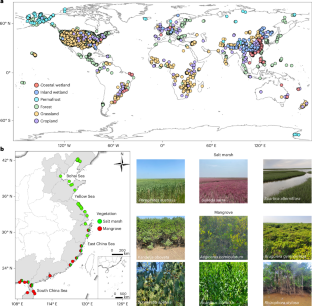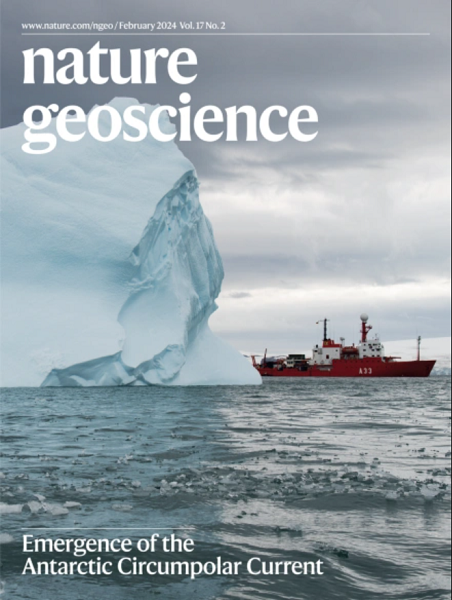全球滨海湿地亚稳铁矿物富集研究
IF 16.1
1区 地球科学
Q1 GEOSCIENCES, MULTIDISCIPLINARY
引用次数: 0
摘要
滨海湿地是陆地-海洋有机碳储存的重要界面。据推测,活性低结晶或短程有序的铁矿物增强了有机碳的积累和持久性。然而,这些亚稳矿物容易快速还原溶解,增加了它们的丰度和对沿海湿地碳循环影响的不确定性,在缺氧通常普遍存在的地方。在这里,我们结合了约23,000个观测数据的全球数据库和中国海岸线的全国调查。研究表明,与高地相比,沿海湿地优先富集低结晶或短程有序的铁矿物,而不是高结晶相。Mössbauer光谱分析显示,在沿海湿地中,氧化铁池主要由水合铁、纳米针铁矿和高度无序相组成,并伴有少量结晶形式,这挑战了反应性亚稳矿物在缺氧条件下优先被去除的观点。我们发现活性亚稳铁在热带湿地最为丰富,而在热带高地,晶体矿物占主导地位。尽管亚稳铁矿物的丰度更高,但沿海湿地与氧化铁相关的总有机碳的比例(约13%)与高地相似。此外,这些广泛存在的亚稳铁矿物没有显示出沿海湿地有机碳饱和的证据,这突出了通过管理实践促进这种生锈的碳汇的潜力。本文章由计算机程序翻译,如有差异,请以英文原文为准。


Enrichment of metastable iron minerals in global coastal wetlands
Coastal wetlands are important land–ocean interfaces for organic carbon storage. It was assumed that reactive poorly crystalline or short-range-ordered iron minerals enhance organic carbon accrual and persistence. However, these metastable minerals are prone to rapid reductive dissolution, raising uncertainties about their abundance and impact on carbon cycling in coastal wetlands, where anoxia typically prevails. Here we combine a global database of ~23,000 observations and a national survey across China’s coastline. We show that coastal wetlands are enriched preferentially in poorly crystalline or short-range-ordered iron minerals over well-crystalline phases, compared with uplands. Mössbauer spectroscopy reveals that ferrihydrite, nanogoethite and highly disordered phases dominated the iron oxide pool in coastal wetlands, with minor crystalline forms, challenging the notion that reactive metastable minerals are removed preferentially under anoxic conditions. We find that reactive metastable iron was most abundant in tropical wetlands, in contrast with tropical uplands where crystalline minerals predominate. Despite a higher abundance of metastable iron minerals, coastal wetlands had a similar fraction of total organic carbon associated with iron oxides (~13%) to uplands. Furthermore, these widespread metastable iron minerals show no evidence of organic carbon saturation in coastal wetlands, highlighting potential for boosting this rusty carbon sink through management practices. Coastal wetlands are enriched in metastable iron minerals over well-crystalline phases and have a similar fraction of iron oxide-associated organic carbon as uplands, according to a global database combined with a survey of China’s coastal wetlands.
求助全文
通过发布文献求助,成功后即可免费获取论文全文。
去求助
来源期刊

Nature Geoscience
地学-地球科学综合
CiteScore
26.70
自引率
1.60%
发文量
187
审稿时长
3.3 months
期刊介绍:
Nature Geoscience is a monthly interdisciplinary journal that gathers top-tier research spanning Earth Sciences and related fields.
The journal covers all geoscience disciplines, including fieldwork, modeling, and theoretical studies.
Topics include atmospheric science, biogeochemistry, climate science, geobiology, geochemistry, geoinformatics, remote sensing, geology, geomagnetism, paleomagnetism, geomorphology, geophysics, glaciology, hydrology, limnology, mineralogy, oceanography, paleontology, paleoclimatology, paleoceanography, petrology, planetary science, seismology, space physics, tectonics, and volcanology.
Nature Geoscience upholds its commitment to publishing significant, high-quality Earth Sciences research through fair, rapid, and rigorous peer review, overseen by a team of full-time professional editors.
 求助内容:
求助内容: 应助结果提醒方式:
应助结果提醒方式:


